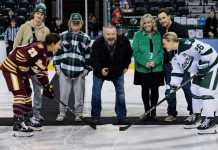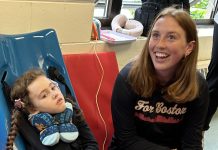— Providence goaltender Matt Curran
Last April, Matt Curran fell off a roof and plummeted 30 feet onto a concrete surface below. He shattered his hip, separated his shoulder, and broke his nose, teeth, and three ribs. Those were the least of his injuries. He had also fractured his skull in two places as well as two vertebrae in his back.
“I was knocked out for a little while,” he says, before adding matter-of-factly, “about a week and a half.”
Once his survival was no longer in question, the stark realities began to unfold. One of the fractured vertebrae had damaged his spinal cord, leaving him paralyzed from the waist down. He transferred from a hospital in Daytona, Florida, where the accident had occurred, to the Shepherd Medical Center, a spinal cord hospital in Atlanta, Georgia. There, he and his family got the chilling prognosis.
“Am I ever going to walk again?” he asked.
“No,” answered his doctor. “The chances are one in 10 million that you’re ever going to move anything below your chest.”
Matt’s father, John Curran, broke down and cried. Matt became severely nauseous.
“It’s a pretty tough thing to put into words what it feels like to hear that,” he says. “Especially when you’re only 21 and you feel like you’ve got so much more to do.”
After the initial shock, he spent several somber days thinking of all the things he had just lost.
From the depths of that depression arose the fighting instincts that had served him so well in his struggle to become a Division I college athlete. Never the superstar who had success just handed to him, he had always had to strive for his goals and overachieve. That had been true at lower levels of hockey where his primary claim to fame was helping Catholic Memorial High School to state and national titles in 1998. It had also been the case at Providence, where in his junior year he had finally seen his first collegiate action, a 39-second stint at the end of a 7-3 win on Dec. 2, 2000.
“I knew my son had a tremendous heart and had been a tremendous fighter,” says John Curran. “He’s always been on the edge of making teams and has been a longshot.”
Matt looked hard at his plight and came to the conclusion that he’d have no chance if he didn’t try. Likening it to training to make a team, he resolved to, in his words, “train for my life.”
Fortunately, it was anything but a solo effort. For starters, he drew on his faith and prayed.
“It was the first time in my life that I’d ever been in something so desperate,” he says. “It was a very, very big help, having someone to look to.”
Matt hastens to add that he doesn’t claim to be the most zealous believer, a point echoed by his father.
“God just kind of scooped him up and took care of him,” says John Curran. “I’m a big believer in God, [but] I’m a back row guy at church. I’m not a holy guy. I’m praying from obstructed view.”
Matt also got constant encouragement from his coaches, teammates and other members of the hockey community.
“I’d get a phone call from one [teammate] and then the phone would go around the room where everyone was hanging out,” he says. “They were all great. All three coaches were unbelievable.
“I owe all of the guys. You get down and out, you’re having a bad day in therapy, and you’re just down there with your family and you’re pretty bummed out and one of these guys calls and tells you what’s going on. It makes you feel pretty good, that you’ve got a lot of support.”
— John Curran, father of Providence netminder Matt Curran
Encouragement also came from total strangers of all ages.
“People who didn’t even know Matt would write letters saying they had seen him play and they were praying for him,” says John Curran. “Little kids from kindergarten would send funny cartoons.”
Matt would need all of that encouragement. Six weeks after his accident, he still had not felt a thing below his waist.
Six weeks…. One in 10 million….
Having a better chance of winning the lottery, he refused to mentally throw in the towel.
“I don’t think I gave up at all in the six weeks,” he says. “I was scared to give up because I [thought], ‘If I give up now, what if I just got it back two seconds ago? I would never know if I stopped trying.’
“You’ve got to tip your hat to people living in wheelchairs, but I just couldn’t see me doing it.”
Finally, after close to seven weeks without a hint of hope, the miracle happened. With his father massaging his left leg, Matt’s big toe suddenly twitched.
“It was a really spiritual moment,” says John Curran. “He thought I had moved his foot, but I said, ‘What are you talking about?'”
They began to cry. For the first time since the accident, Matt had a chance.
Working extraordinarily hard and “praying even harder,” the Curran family — Matt, his father John and his mother Janet — saw the miracle unfold. Every couple days, Matt would experience a new breakthrough. Days after the first twitch, he moved his knee. Soon after, he was moving his left leg pretty well and the attention turned to his right side.
Progress was slower there, but steady. After a couple weeks, he’d gotten back some of his right leg, leaving his midsection as the biggest concern. Both legs were working, but he still had nothing in the pelvis and hip area, where a metal hip had been inserted. There were no guarantees that the improvement would continue and without the midsection Matt still wouldn’t be able to hold himself upright.
With the same tenacity in his therapy sessions that had gotten him that far, Matt overcame the last hurdle to walking again.
“I’ll tell you, we were in the gym when the gym was closed,” says John Curran. “We’d sneak into the gym at that hospital [to do more therapy work]. By the time the janitors left, [they] said, ‘You guys will get the lights, right?’
“He was teaching himself how to crawl, how to walk all over again. ‘More weight, Dad,’ he’d say. ‘More pushups.’
“It was an incredible, incredible journey. Having that willingness to fight and having a huge heart is what made him walk out of that place.
“I tell you, one day when he stood up for the first time, the entire place started screaming and crying and clapping. It was like Rocky all over again.”
Matt’s progress continued until it became clear that it was time for him to leave the Shepherd Medical Center.
“It’s a long recovery from a spinal cord injury,” he says, “but by that time I was doing well enough to make room for someone else to come in who needed my bed a little more. I was working on doing stairs and other [patients] were looking at me with those eyes. I [thought], ‘I’ve got to get out of here.'”
Less than a month after the breakthrough twitch in his toe, he walked out of the hospital using only a crutch and a leg brace.
“The doctors said there was no reason why this was happening,” says Matt. “But one of them said that you don’t ask why when it’s something good.” Matt smiles and adds, “No one is asking why.”
He now walks without any assistance and dreams of the day when he might return to competitive hockey at some level.
“I’d like to think that I’d be able to,” he says. “I’m the kind of kid that once I get [back the ability to walk], I want more. I’ve tried skating and it’s pretty tough. It’s muscle memory that I’ve got to work on, but I’m working on trying to run and jump and stuff like that. All cool stuff.”
His role with the team has been to help out with the goaltenders.
“Coach [Paul Pooley], like he’s been the whole time, has been unbelievable,” says Matt. “He really left it up to me as to what I wanted to do in terms of the team, whether I wanted to be on it at all or if I never wanted to come down [to the rink]. It was up to me. Obviously, I want to be here as much as I can, because this is what I want to do.
“So I’ve been trying to help out, trying to be another set of eyes on the goalies because you can never have too many people trying to see what’s going on. So I help out like that during the games and during the week I’m down here [at the rink] every day. I do most of my therapy here on my own and then I go to my therapist.
“I’m here a lot, working on trying to get back on the ice.”
Matt’s injury and miraculous comeback have changed him more than just physically.
“It gives you a new perspective on everything,” he says.
His perseverance in the face of overwhelming odds has left an indelible mark on those around him and will no doubt serve him well in the years to come.
“It’s the foundation for life,” says John Curran. “Hockey is a pyramid and everyone falls off eventually. It’s what you take from the game that holds you in good stead in life because life is all about battles.
“He’s been an inspiration to me and our family. This is a tough kid who has just really bounced back. This has been his greatest victory.”


